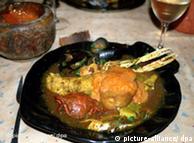樂諾特賀(Gaston Lenôtre)從小就展露對於甜點的興趣與天分,二十七歲那一年給自己的 生日禮物即是在家鄉開設了第一家甜點專賣店。十年之後,與妻子聯手在巴黎第十六區 ... 劇院蛋糕是六O年代由Gaston Lenôtre發明,這位1920年生於諾曼地的天才甜點師,1947年 設立第一家甜點店後,隨後於1950年頂下位於巴黎Auteuil街44號的蛋糕店,並一舉成名 ...
Inside Europe | 31.01.2009 | 07:05
The Legacy of France's Culinary Maestro
It was once said of him that his name on a cake was as important as that of Christian Dior on a dress. President Sarkozy paid tribute to him, saying Lenotre raised patisserie to the rank of an art. The chef built up a large catering and restaurant empire, as well as a successful cookery school outside Paris.
Gaston Lenôtre, Who Built a Culinary Brand, Is Dead at 88
PARIS — Gaston Lenôtre, founder of the restaurant, catering, retail and cooking school empire Lenôtre, which embodies French savoir-vivre and savoir-faire, especially in the art of pastry, died Thursday at his home in Sennely, in the Sologne region south of Paris. He was 88.

Gaston Lenôtre in 1974. He exported French flair and decorum.
His death was announced by his company. The cause was cancer, said Marie-Jo Dalibard, a spokeswoman for Mr. Lenôtre’s first wife, Colette, with whom he started his first Paris pastry shop.
Mr. Lenôtre was the exacting patriarch of French pâtisserie. He rejuvenated pastry making in the early 1960s and then created a worldwide group of 60 boutiques in 12 countries, which can cater to every whim, from truffled pâté for 25,000 guests, to a banquet for the queen of England, all with French flair, service and decorum.
Pierre Hermé, one of France’s leading pastry chefs, who became an apprentice at Lenôtre at 14, recalled in a telephone interview Thursday that Mr. Lenôtre “dusted, lightened and modernized the heavy pastries of the 1950s.” He added, “He made them lighter, more pleasureful, more desirable, and that’s fundamental in the world of pâtisserie.”
Gaston-Albert-Celestin Lenôtre was born May 28, 1920, on a small farm in Normandy. Both of his parents worked in restaurants in Paris, and after his father’s illness forced them back to Normandy, he struggled to find a place in a restaurant kitchen. Before World War II broke out, he peddled homemade chocolates in Paris on his bicycle for pocket money.
After the war, Mr. Lenôtre opened his first bakery in the small Normandy town of Bernay. Success there led him to buy a small, struggling bakery in the fashionable and quiet 16th Arrondissement in Paris in 1957, with Colette.
Mr. Lenôtre was immediately successful. His cakes, pastries and chocolate creations presaged the arrival of nouvelle cuisine of the early 1970s, which demanded a return to simple preparations and the freshest ingredients. He cut the cream, lightened the mousses and focused on quality ingredients, like good butter.
In 1964 Mr. Lenôtre started the catering service, which, thanks to new techniques in freezing during production and the inclusion of gelatin to stabilize mousses, quickly mushroomed from weddings and small events to serving thousands at a time.
In 1971, Mr. Lenôtre opened a cooking school in Plaisir, west of Paris, to train professional pastry chefs. The legion of cooks who passed through his schools or his kitchens have helped preserve and transform the rest of the industry. “He really understood that without transmission, his profession had no future,” Jean-Claude Ribaut, the food critic for the newspaper Le Monde, said in an interview.
David Bouley, a chef who runs several restaurants in New York and who attended the Lenôtre school, recalled four intense days under Mr. Lenôtre devoted solely to egg whites.
“I remember those days so well, and how clear and articulate he was,” Mr. Bouley said in a telephone interview. “He was a master at building production. He was the first one to use gelatin in his buttercreams, and to make such extensive use of the freezer.”
In April 1974, Mr. Lenôtre sent Michel Richard, who was his apprentice at 20 and who now runs several successful restaurants in the United States, to open Chateau France on East 59th Street in New York City. An 80-seat restaurant and pâtisserie, it was meant to showcase the Lenôtre style.
“It closed a year later,” Mr. Richard said. “Americans weren’t ready for his pastries. They could only feed one person, whereas American cakes were much richer.”
Not discouraged, Mr. Lenôtre opened a store in Berlin in 1975, quickly extending to Japan and the Middle East.
In 1985 Lenôtre was taken over by Accor, a major French hotel group. In 2008, Lenôtre’s revenues were $162 million. Lenôtre, which has 18 boutiques in France alone, has also owned the three-star Paris restaurant Le Pré Catelan since 1976.
“Lenôtre is a luxury brand like Chanel, this lightness in the cakes that comes from only working with quality,” Patrick Scicard, who has been director and general manager of Lenôtre since Mr. Lenôtre’s retirement, said in a telephone interview.
Mr. Lenôtre’s survivors include his second wife, Catherine; and three children, Alain, Sylvie and Annie; his younger brother, Marcel; 8 grandchildren; and 10 great-grandchildren. His nephew Patrick is a chef in Paris, and his grandson Serge Gilles-Naves has a restaurant in the South of France. Many of the pastries elaborated by Mr. Lenôtre are still sold in the boutiques. The Opéra, an almond bread with coffee cream and chocolate frosting; the Succès, an almond meringue cake with nougatine and almond praline; and the Feuille d’Automne, a cake composed of almond and vanilla meringue with dark chocolate mousse — are all original Lenôtre recipes.
“When you’ve been at Lenôtre, it’s like a drug,” Mr. Richard said. “You’ve been injected with his recipes that you have to carry your whole life.”








